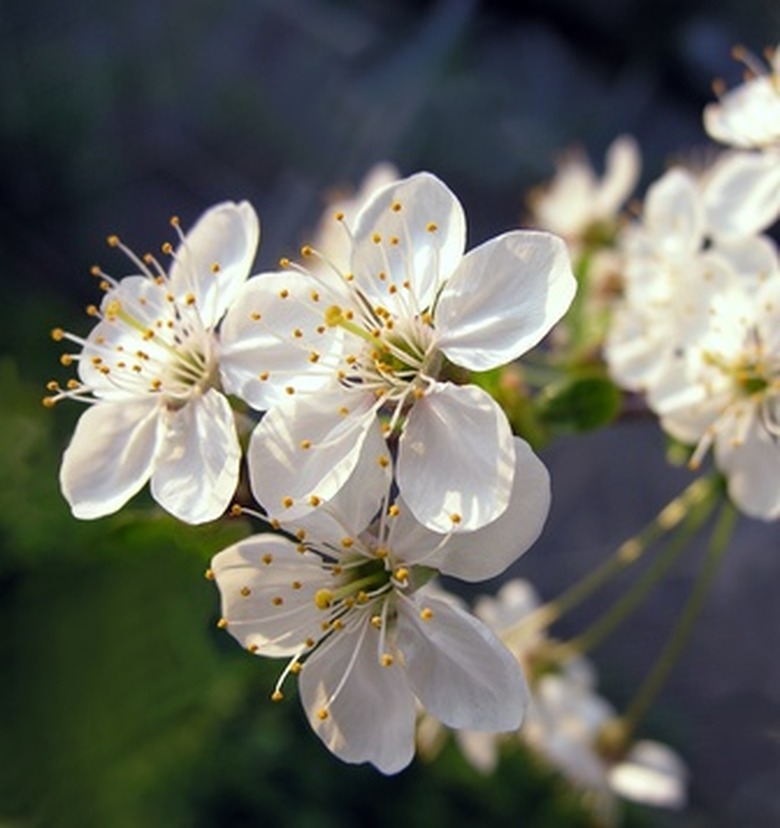Wild Fruit Tree Identification
Wild fruit trees occur throughout North America, with many belonging to the Rose family, such as the crabapples, plums, hawthorns and cherries. Others, such as the persimmon and mulberry, are members of other plant families. Identification of these wild fruit trees is possible when you acquaint yourself with the varying characteristics that these trees possess.
Size
For the most part, the wild fruit trees of North America are small, with only a handful of species considered a medium-sized tree. The plums, hawthorns and apple trees typically do not grow taller than 30 feet, with many often appearing shrubby. The common persimmon, red mulberry and some of the types of wild cherry trees can exceed 50 to 60 feet in height. Black cherry can top 80 feet on occasion, notes the "National Audubon Society Field Guide to Trees."
- Wild fruit trees occur throughout North America, with many belonging to the Rose family, such as the crabapples, plums, hawthorns and cherries.
- The plums, hawthorns and apple trees typically do not grow taller than 30 feet, with many often appearing shrubby.
Leaf Types
Recognizing the foliage that develops on wild fruit trees enables you to identify the species or to have a better understanding of what the fruit tree may be. Cherry leaves typically are elliptical, apple leaves are oblong to ovate and the mulberries have leaves featuring no lobes, or they may have one or two, often on the same branch. The leaves of the hawthorns differ between species, but almost all have sharply toothed edges. Common persimmon has oblong leaves that can reach 6 inches in length.
Features of Flowers
Wild fruit tree blossoms are a welcome sign of spring and even more welcome for someone attempting to identify a particular tree. Those of most of the plums emerge even before the leaves do, with a pungent aroma. The apples, such as the sweet crabapple, are white and/or pink, fragrant and have five petals. Cherry blossoms develop in clusters or on long stalks known as racemes. Mulberry trees feature flowers that resemble hanging greenish spikes.
- Recognizing the foliage that develops on wild fruit trees enables you to identify the species or to have a better understanding of what the fruit tree may be.
- The apples, such as the sweet crabapple, are white and/or pink, fragrant and have five petals.
Considerations
Considering the fruit that finally develops on wild fruit trees can be the final piece to the puzzle of its identification if you are still uncertain. Red mulberries look like large elongated blackberries, about 1.3 inches long. Many crabapples, including the prairie crabapple, are small compared to cultivated varieties, with a yellow-green color. Persimmons are a combination of red, orange or purple and approximately 1.5 inches across. Plums vary in color. Those on a hortulan plum tree are red, while the fruit of the flatwoods plum is normally blackish purple.
Geography
Where specific species of wild fruit trees grow can help you figure out a specimen's identity in your part of the continent. Using the cherries as an example, you would see that the black cherry is common in the eastern half of the United States; the pin cherry is found throughout most of the northern states from Minnesota eastward; the common chokecherry covers a wide range, from coast to coast and through most of the Northeast, Midwest, Great Plains and Rocky Mountains. Other cherries, though, have a much more limited distribution, including bitter cherry, which occurs only in the Far West.
- Considering the fruit that finally develops on wild fruit trees can be the final piece to the puzzle of its identification if you are still uncertain.
- Many crabapples, including the prairie crabapple, are small compared to cultivated varieties, with a yellow-green color.
References
- Texas Forest Service Trees of Texas: List of Trees
- "Trees of North America"; C. Frank Brockman; 1996
- "National Audubon Society Field Guide to Trees"; Elbert L. Little; 2008
